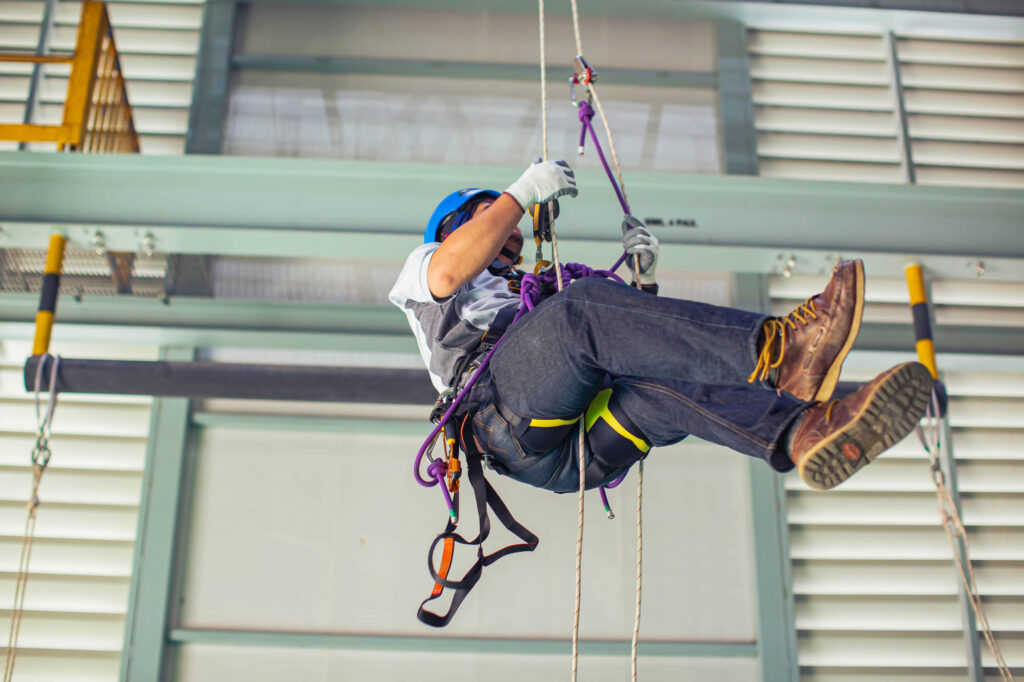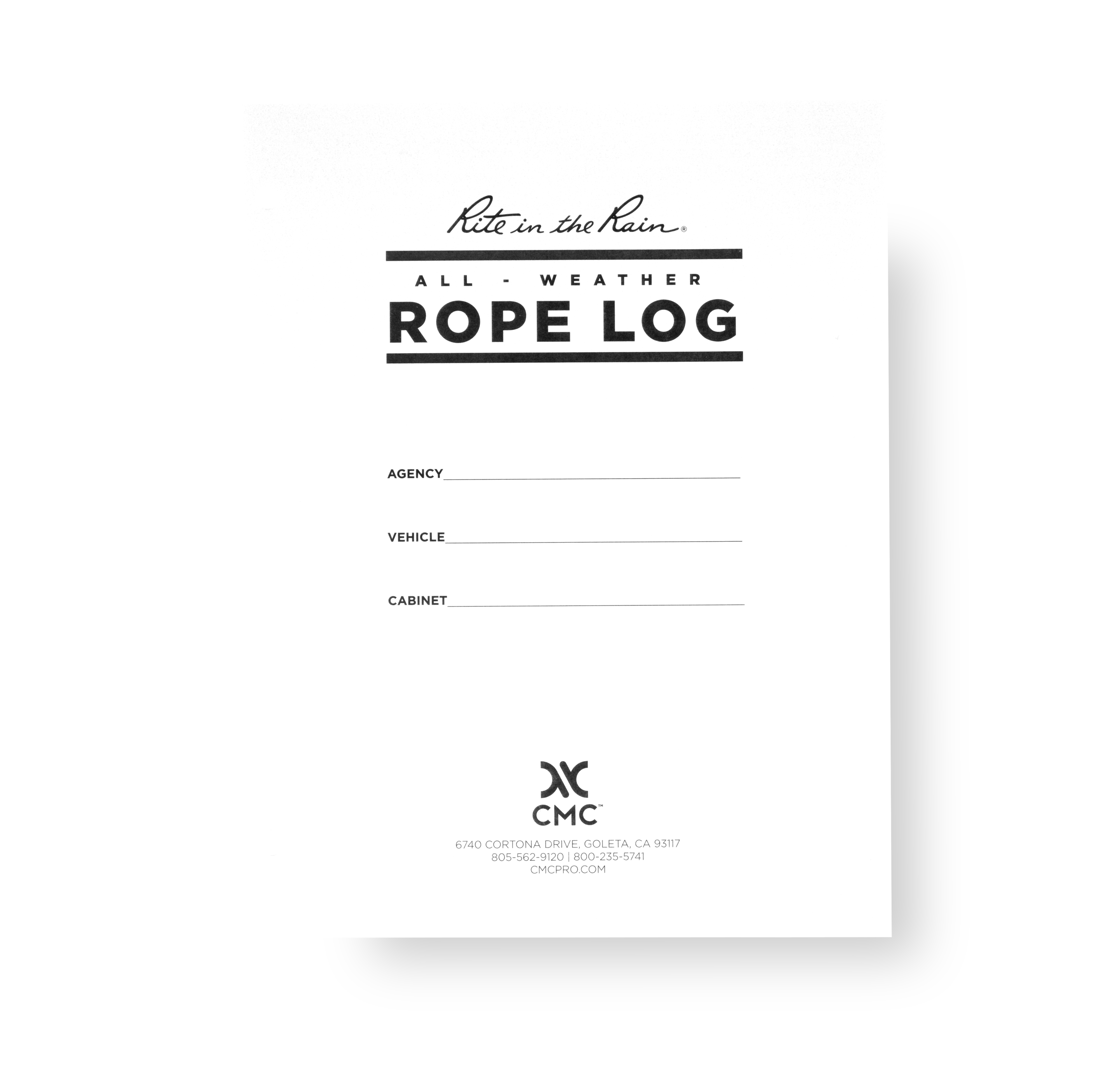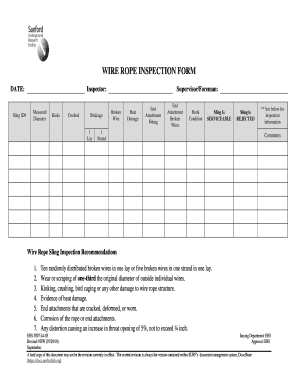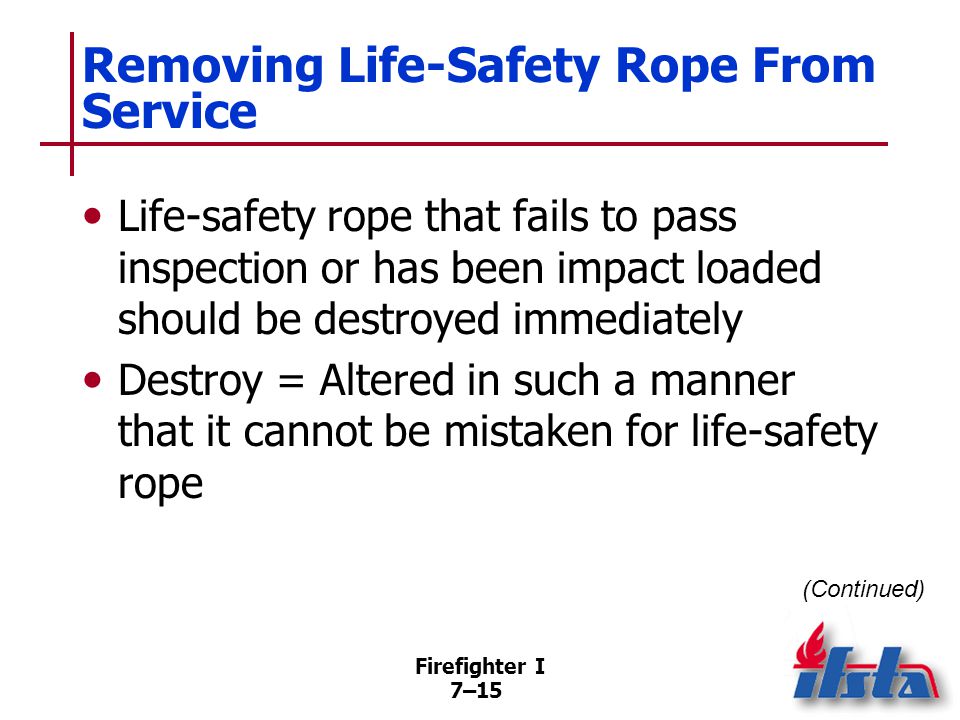
Chapter 7 Lesson Goal After completing this lesson, the student
Specific Objectives 1. Compare and contrast the characteristics of life-safety rope and utility rope. 2. Summarize criteria for reusing life-safety rope. 3. Describe rope materials. (Continued) Firefighter I
Chapter 7 Lesson Goal After completing this lesson, the student shall be able to apply basic use of ropes and knots following the policies and procedures.
Chapter 7 — Ropes and Knots. Firefighter I.
After completing this lesson, the student shall be able to apply basic use of ropes and knots following the policies and procedures set forth by the authority having jurisdiction (AHJ). Firefighter I.
2. Summarize criteria for reusing life-safety rope. 3. Describe rope materials. (Continued) Firefighter I.
5. Summarize basic guidelines for rope maintenance. 6. Explain procedures for storing life-safety rope. 7. Describe webbing and webbing construction. (Continued) Firefighter I.
10. Describe characteristics of knots commonly used in the fire service. (Continued) Firefighter I.
13. Discuss rescue rope and harness. 14. Inspect, clean, and store rope. (Skill Sheet 7-I-1) (Continued) Firefighter I.
16. Tie the single overhand knot. (Skill Sheet 7-I-3) 17. Tie a bowline. (Skill Sheet 7-I-4) 18. Tie a clove hitch. (Skill Sheet 7-I-5) (Continued) Firefighter I.
21. Tie a figure-eight bend. (Skill Sheet 7-I-8) 22. Tie a figure eight on a bight. (Skill Sheet 7-I-9) (Continued) Firefighter I.
24. Hoist an axe. (Skill Sheet 7-I-11) 25. Hoist a pike pole. (Skill Sheet 7-I-12) 26. Hoist a roof ladder. (Skill Sheet 7-I-13) (Continued) Firefighter I.
28. Hoist a charged hoseline. (Skill Sheet 7-I-15) 29. Hoist a power saw. (Skill Sheet 7-I-16) Firefighter I.
Must be block creel construction using continuous filament virgin fiber for load-bearing elements. Firefighter I.
Industry standards exist concerning physical properties. No standards for applications. Regularly inspect for damage. Firefighter I.
Maintenance procedures. Criteria for retiring life-safety rope from service. (Continued) Firefighter I.
Must not show abrasions or have been exposed to high temps/direct flame contact. Has not been impact loaded. (Continued) Firefighter I.
Must not have been exposed to any substance that can deteriorate rope. Must pass inspection made by qualified person before AND after use. Firefighter I.
Life-safety rope that fails to pass inspection or has been impact loaded should be destroyed immediately. Destroy = Altered in such a manner that it cannot be mistaken for life-safety rope. (Continued) Firefighter I.
Rope subjected to impact loading must have entry made in log because there is no way to determine by inspection if it has been impact loaded. Firefighter I.
Courtesy of BlueWater Ropes. (Continued) Firefighter I.
Can be used for utility purposes. Made of short overlapping strands of fiber. Firefighter I.
Excellent resistance to mildew and rotting, excellent strength, easy to maintain. May feature continuous fibers running entire length of rope. (Continued) Firefighter I.
Designed to stretch without breaking. Elasticity a disadvantage when raising/lowering heavy loads. Not practical for rescue or hauling applications. Firefighter I.
Low stretch without breaking. According to NFPA® 1983, must not elongate more than 10 percent when tested under load equal to 10 percent of breaking strength. Used for rescue, rappelling, hauling. Firefighter I.
Minimum breaking strength of 4,500 pounds (20 k/N) Maximum safe working load limit of 300 pounds (136 kg) Firefighter I.
7/16-inch (11 mm) diameter or greater, less than or equal to ⅝-inch (16 mm), intended to support two persons. Minimum breaking strength of 9,000 pounds (40 k/N) Maximum safe working load limit of 600 pounds (272 kg) Firefighter I.
19/64-inch (7 mm) diameter or greater, but less than 3/8-inch (9.5 mm), used to tether rescuers during water rescues or to throw to victim in water. Minimum breaking strength of 3,000 pounds (13 k/N) Maximum safe working load limit of 200 pounds (91 kg) Firefighter I.
Must meet generally the same requirements as throwline. Intended to be used only one time then destroyed. Firefighter I.
Kernmantle rope. Laid (twisted) natural or synthetic rope. Courtesy of BlueWater Ropes. (Continued) Courtesy of BlueWater Ropes. Firefighter I.
Braided rope. Braid-on-braid rope (double braid) Courtesy of BlueWater Ropes. Courtesy of BlueWater Ropes. Firefighter I.
Inspect all types after each use. Unused should be inspected at least annually. Inspect visually and by touch. Inspect for foreign objects; if found, take out of service. All inspections documented in log. Firefighter I.
Kernmantle rope. Laid rope. Braided rope. Braid-on-braid rope. Firefighter I.
Record must be started and kept throughout rope’s working life. Firefighter I.
Can be stored in coils or rope bags. Should be stored in clean, dry spaces with adequate ventilation. Not exposed to chemical contaminants. Not stored in same space with gasoline-powered tools, spare fuel. (Continued) Firefighter I.
Advantage of storing synthetic rope in bag is that rope can be deployed quickly. (Continued) Firefighter I.
Bag may have drawstring and shoulder straps for ease in carrying. Firefighter I.
Coiling necessary so rope may be placed into service with minimum delay important in fire service. Improperly coiled rope may become tangled and fail to uncoil. Firefighter I.
Most made from same materials as synthetic rope; same precautions, maintenance procedures apply. Size needed varies with intended use. Firefighter I.
Two designs — One solid, flat; other tubular. Both look the same unless viewed at ends. Tubular is of two designs: spiral and chain weave. Spiral stronger, more resistant than chain. Firefighter I.
Standing part — Section between working end and running end. Firefighter I.
Knots are used to join or connect ropes or webbing, form loops in ropes or webbing or attach ropes or webbing to objects. Should be dressed after tied. Even properly dressed knots can fail. Firefighter I.
Rope’s strength reduced whenever bent. Bight, loop, round turn — Bends in rope. Knots, hitches formed by combining bending elements. Firefighter I.
Knot Elements Round turn — Consists of further bending one side of loop Firefighter I
Can be used when tying any type of knot. Best to provide highest level of safety. Use eliminates danger of end of rope slipping back through knot and causing failure. (Continued) Firefighter I.
Easily tied, untied; good for forming single loop that will not constrict object it is placed around. Firefighters should be able to tie in the open as well as around objects. (Continued) Firefighter I.
Particularly useful in stabilizing tall objects being hoisted; always used with another knot or hitch. Formed by making round turn around object. Several can be applied in succession if required. (Continued) Firefighter I.
Highly susceptible to failure. May be formed anywhere in rope. Withstands steady pull in either direction. May need to be backed up with overhand safety knot. (Continued) Firefighter I.
Figure-eight bend. Figure eight on a bight. Figure-eight follow through. (Continued) Firefighter I.
Used for joining two ropes of unequal diameters or joining rope and chain. Unlikely to slip when rope is wet. Advantages make it useful, dependable in fire service rope work. Not suitable in life-safety applications. (Continued) Firefighter I.
Preferred knot for joining two pieces of webbing or ends of same piece when loop needed. Formed by tying simple overhand knot in one piece or end and following through in reverse direction with another piece or end. Firefighter I.
Carabiner. Figure-eight plate (descender) (Continued) Firefighter I.
Brake bar rack (descender) Ascender. (Continued) Firefighter I.
One of most common uses of rope in fire service — Raise or lower tools and pieces of equipment from one elevation to another. Thorough knowledge of knots, hitches makes this a safe, efficient practice. (Continued) Firefighter I.
Anything with closed-type D-ring handle can be raised, lowered with bowline or figure-eight bend. Hoisting pressurized cylinders not recommended. (Continued) Firefighter I.
Using proper knots, securing procedures helps prevent dropping of equipment. Separate guideline may be tied to any of these pieces of equipment; objects may also be tied in center of rope. Firefighter I.
Have solid footing, make necessary preparations beforehand. Use hand-over-hand method. Use edge roller or padding. Work in teams. (Continued) Firefighter I.
Look to ensure all personnel clear of hoisting area. Avoid hoisting operations near electrical hazards. Secure nozzles of charged hoselines. Use guideline to help control object being hoisted. Firefighter I.
Used for variety of purposes. Firefighter I.
Rescue Harness Three classes Class I Class II Class III Firefighter I
Rope is one of the oldest and most basic tools used by firefighters. It is used to stabilize vehicles and other objects, hoist tools and equipment aloft, and to allow firefighters to access and rescue victims who are stranded above or below grade, or in bodies of water. (Continued) Firefighter I.
To use rope safely and effectively during fires and rescue operations, firefighters must know the various types of rope and their applications. They must also be capable of tying a variety of knots and hitches quickly and correctly — and that takes practice. (Continued) Firefighter I.
2. List three criteria that life-safety rope must meet before it is reused in life-safety situations. (Continued) Firefighter I.
5. Describe the most common types of rope construction. (Continued) Firefighter I.
7. What are general guidelines for cleaning synthetic fiber rope (Continued) Firefighter I.
9. Describe commonly used rope hardware. 10. List four safety considerations for hoisting tools and equipment. Firefighter I.

Section 4 Raising and Lowering Environments b Low angle b Rescuer

Personal Finance Notes Ch. 7 - Morgan Horton 22-23 - Chapter 7 - College Planning Lesson 1 - The - Studocu
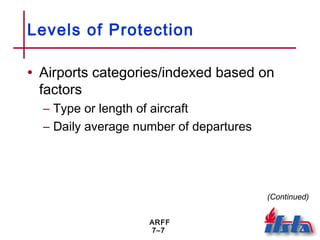
Chapter 07 Apparatus

FIRE SERVICE Ropes & Knots IFSTA Ch ppt video online download

Learning Goals & Objectives in Course Design: How To Prepare a Great Lesson Plan (2024)

Helen Keller
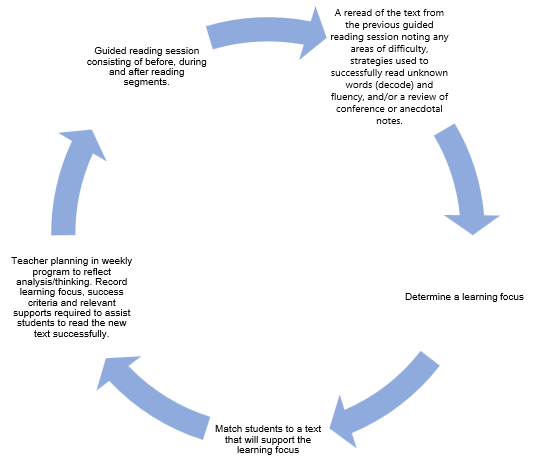
Guided reading
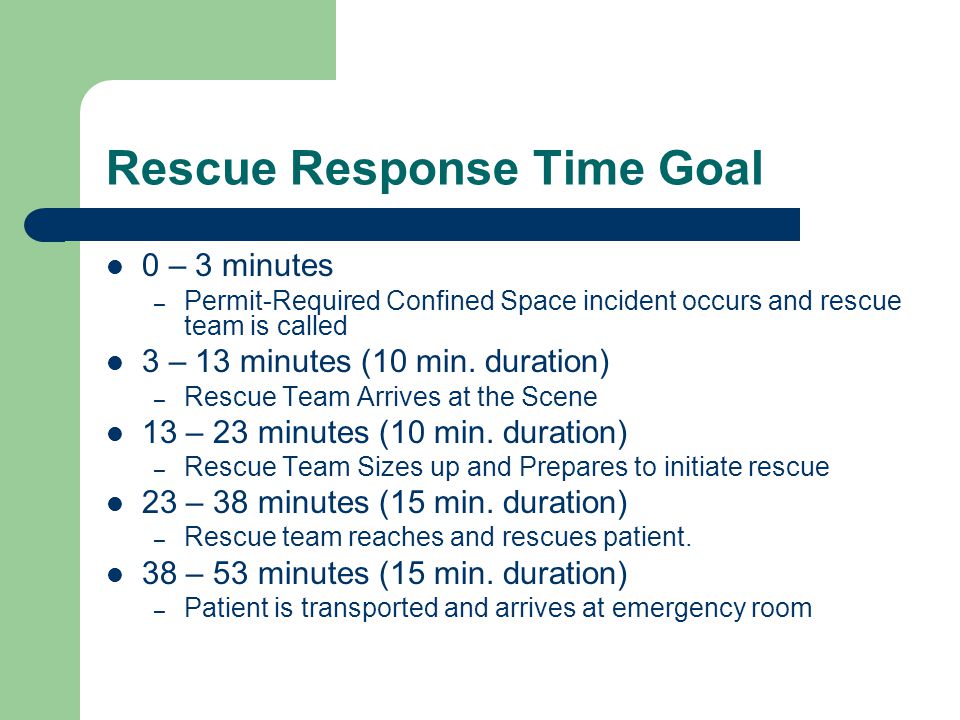
Confined Rescue – A Timeline to Rescue - ppt video online download

27+ Easy-to-Edit Lesson Plan Examples [+ Writing Tips]

Intermediate SFFMA Objectives: – Hrs received. - ppt download

Chapter 19 Lesson Goal After completing this lesson, the student shall be able to communicate effectively by radio and through various reports following. - ppt download

CHAPTER 15 Copyright © 2007 Thomson Delmar Learning 15.1 Ropes and
